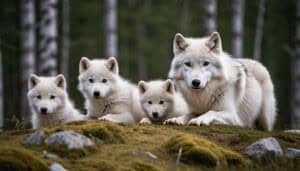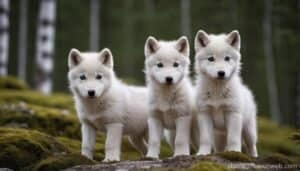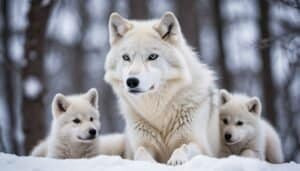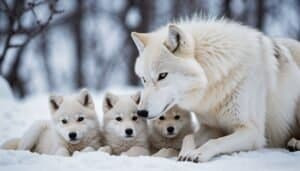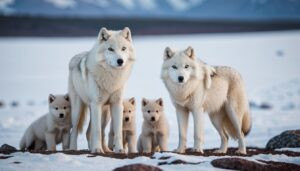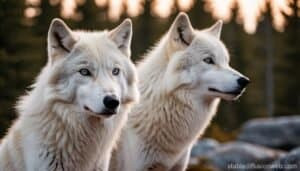Introduction
Arctic wolf pups begin their journey into the wild with a critical phase of learning to hunt. This article explores the age at which these young wolves start hunting, the initial prey they pursue, and the success rates of their early hunts
Additionally, it delves into the challenges faced by these young hunters and the impact of the harsh Arctic environment on their training. Through this comprehensive guide, we will gain a deeper understanding of the early hunting experiences of Arctic wolf pups and their development into skilled predators
Age Arctic Wolf Pups Begin to Hunt
Arctic wolf pups, born in the harsh conditions of the Arctic tundra, begin their journey into the world of hunting at a remarkably young age. Typically, Arctic wolf pups start learning to hunt at around 8 to 10 weeks old
At this stage, they are still heavily dependent on their parents and the pack, but the process of learning essential survival skills has already begun
Early Hunting Behaviors of Arctic Wolf Pups
In the early stages of their hunting education, Arctic wolf pups exhibit a variety of exploratory behaviors. These behaviors include play-fighting with their siblings, chasing small objects, and mimicking the actions of adult wolves
These playful activities are crucial as they help the pups develop the physical skills and coordination necessary for successful hunting later in life
Observational learning is another critical aspect of their early hunting behaviors. Pups closely watch the adults in the pack as they hunt, noting techniques and strategies. This period of observation allows the pups to understand the basics of stalking, pouncing, and delivering a killing bite, even before they participate in actual hunts
Role of Adult Wolves in Hunting Training
The role of adult wolves in the hunting training of pups cannot be overstated. Adult wolves serve as both protectors and educators. Initially, the adults bring back food to the den, where the pups can observe the preparation and consumption of prey. This indirect exposure to hunting is the first step in their training
As the pups grow older, the adults involve them more directly in hunting activities. Adult wolves may allow the pups to accompany them on hunts, providing them with the opportunity to practice their skills in a controlled environment
During these excursions, the adults often demonstrate various hunting techniques and encourage the pups to participate in the chase and capture of prey. This hands-on training is vital for the pups’ development and increases their chances of survival as independent hunters
Development of Hunting Skills Over Time
The development of hunting skills in Arctic wolf pups is a gradual process that extends over several months. Initially, their attempts at hunting are clumsy and often unsuccessful. However, through persistent practice and guidance from adult wolves, the pups’ skills improve steadily
By the age of six months, many Arctic wolf pups are capable of participating in coordinated pack hunts. Their growing size and strength, combined with their increasing experience, enable them to contribute effectively to the pack’s hunting efforts
Despite this progress, it can take up to a year or more for the pups to become fully proficient hunters capable of surviving on their own
During this developmental period, the pups also learn to adapt their hunting strategies to the changing Arctic environment. Seasonal variations in prey availability and harsh weather conditions require them to be flexible and resourceful
The ability to hunt efficiently in such a demanding environment is a testament to the rigorous training and experience they receive from their pack
Initial Prey and Success Rates
Arctic wolf pups face numerous challenges as they embark on their hunting journeys. The types of prey they target, their success rates, and the obstacles they encounter are all critical aspects of their development as hunters
Understanding these elements provides insight into the survival and growth of these young predators in the harsh Arctic environment
Types of Prey Hunted by Young Pups
In the early stages of their hunting careers, Arctic wolf pups typically target smaller and more manageable prey. Their initial hunts often focus on small mammals such as Arctic hares, lemmings, and birds
These animals are abundant in the Arctic tundra and provide an ideal starting point for young hunters to practice their skills
As the pups grow and gain more experience, they begin to participate in hunts for larger prey alongside adult wolves. Caribou and musk oxen become primary targets as the pups develop the strength and coordination needed to take down these formidable animals
The transition to hunting larger prey is gradual, with pups initially playing supportive roles during the chase and learning to work as part of a coordinated pack
Success Rates of Early Hunts
The success rates of Arctic wolf pups in their early hunts are relatively low. Young wolves lack the experience and precision of their adult counterparts, leading to frequent failures and missed opportunities. However, these early failures are crucial learning experiences that help the pups refine their techniques and strategies
Adult wolves often assist in increasing the success rates of the pups’ hunts by intervening when necessary and ensuring that the pack secures food. This support allows the pups to practice without the dire consequences of failure, such as starvation
Over time, as the pups’ skills improve and they gain more experience, their success rates gradually increase
Challenges Faced by Young Hunters
Arctic wolf pups face a myriad of challenges as they learn to hunt. One of the primary obstacles is the harsh and unforgiving Arctic environment. Extreme cold, deep snow, and limited visibility can make hunting difficult and dangerous for inexperienced pups
Additionally, the scarcity of prey during certain times of the year adds to the difficulty of securing food
Competition within the pack is another challenge. Young wolves must compete with their siblings and adult pack members for limited resources. This competition can be fierce, but it also fosters the development of essential hunting skills and resilience. Learning to navigate pack dynamics and assert themselves during hunts is a vital part of the pups’ growth
Predation risk is another significant challenge. While Arctic wolves are apex predators, young pups are vulnerable to attacks from other predators such as polar bears and eagles
Staying close to the pack and relying on the protection of adult wolves is crucial for their survival during their formative months
Impact of Environment on Hunting Training
The Arctic environment plays a pivotal role in shaping the hunting skills and strategies of Arctic wolf pups. The harsh conditions, seasonal variations, and survival strategies adopted by these young wolves are all influenced by the unique challenges of their habitat
Environmental Factors Affecting Hunting Training
The Arctic tundra is characterized by extreme conditions that significantly impact the hunting training of Arctic wolf pups. The perpetual cold, strong winds, and deep snow present formidable obstacles for young wolves learning to hunt
These conditions require the pups to develop specialized skills to navigate and hunt efficiently in their environment
Snow and ice cover can hinder the movement of young wolves, making it difficult for them to chase and capture prey. As a result, Arctic wolf pups learn to conserve energy and use stealth and ambush techniques rather than relying solely on speed and endurance
The ability to move silently and blend into their surroundings becomes crucial for successful hunting in such a challenging landscape
Additionally, the sparse vegetation and open terrain of the tundra limit the availability of cover for stalking prey. Pups must learn to use the natural features of the environment, such as snowdrifts and rocky outcrops, to conceal themselves during hunts
This requires a keen understanding of their surroundings and the ability to adapt their hunting strategies to the terrain
Seasonal Variations in Hunting Training
Seasonal changes in the Arctic have a profound impact on the hunting training of Arctic wolf pups. The long, harsh winters and brief, intense summers create distinct periods of prey availability and scarcity that influence the pups’ hunting behaviors
During the winter months, the scarcity of prey and the difficulty of hunting in deep snow make it challenging for young wolves to find food. Pups must learn to endure long periods of hunger and rely on the adults in the pack to provide sustenance. This period of scarcity teaches the pups the importance of conserving energy and honing their hunting skills to maximize success when opportunities arise
In contrast, the summer months bring a relative abundance of prey as migratory animals such as caribou return to the tundra. This period provides an opportunity for the pups to practice and refine their hunting techniques
The increased availability of prey allows for more frequent hunting attempts and a higher success rate, contributing to the rapid development of the pups’ skills
The seasonal cycle of abundance and scarcity also teaches the pups to anticipate changes in prey behavior and adapt their hunting strategies accordingly. This adaptability is essential for their survival in the dynamic and unpredictable Arctic environment
Survival Strategies of Young Arctic Wolves
Survival in the Arctic requires a combination of learned behaviors and innate instincts. Young Arctic wolves develop a range of survival strategies to cope with the harsh conditions and limited resources of their environment
One of the key strategies is cooperative hunting. Pups learn the importance of working together with their pack members to take down larger prey and increase their chances of success. This cooperation not only improves hunting efficiency but also strengthens the social bonds within the pack, ensuring mutual support and protection
Another important strategy is the ability to scavenge. In times of prey scarcity, Arctic wolf pups learn to take advantage of carrion and leftover kills from other predators. This opportunistic behavior helps them survive during periods when active hunting is not feasible
Adaptability is a crucial survival trait for Arctic wolf pups. They must be able to modify their hunting techniques and strategies in response to changing environmental conditions and prey availability. This flexibility allows them to thrive in one of the most challenging habitats on Earth
Conclusion
The journey of Arctic wolf pups from birth to becoming proficient hunters is a fascinating and complex process, deeply influenced by their environment and social structure. Starting at around 8 to 10 weeks old, these pups begin to learn the essential skills needed for survival
Their early hunting behaviors, characterized by play and observation, lay the foundation for more advanced techniques learned through direct involvement in hunts with adult wolves. The initial prey targeted by young pups, such as small mammals and birds, provides practical experience and helps build their confidence
Success rates for these early hunts are low, but with persistence and guidance from adult wolves, the pups’ skills gradually improve. The Arctic environment poses significant challenges, including extreme cold, deep snow, and seasonal variations in prey availability. These factors necessitate the development of specialized hunting strategies, such as using stealth and ambush techniques, and adapting to the terrain
The cyclical nature of prey availability throughout the seasons further shapes the pups’ hunting training, teaching them to endure scarcity and capitalize on abundance. Survival strategies, such as cooperative hunting and scavenging, are essential for overcoming the harsh conditions and ensuring the survival of the pack
Through this intricate and demanding process, Arctic wolf pups transform into adept hunters, capable of thriving in one of the planet’s most extreme environments. The combination of learned behaviors, innate instincts, and the support of their pack enables them to navigate the challenges of the Arctic tundra and maintain the delicate balance of their ecosystem


